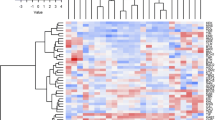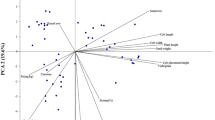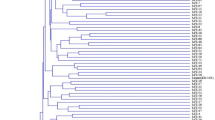Abstract
Algerian maize has been cultivated in Saharan Oases for many centuries, determining its adaption to extreme environments. Therefore, maize landraces from Sahara could be considered as valuable genetic resources for breeding. Morphological and molecular characterization of fifty-six populations were assessed using 14 agro-morphological traits and 18 SSR markers. Populations were evaluated in field experiment in an augmented randomized complete block design. ANOVA on morphological data revealed significant difference among populations. Analysis of principal component showed two principal components describing 55.44% of total variation. Flowering time, plant height, ears traits and yield were the most discriminatory traits. Genetic analysis identified a large number of alleles (191) with mean value of 10.61 alleles per locus. High average PIC value (0.57) indicates informativeness of the selected markers in this study. The genetic structure analysis revealed a high genetic differentiation (Fst = 0.22) among populations, showing a greater genetic diversity within Algerian populations than among them. Bayesian model-based structure analysis assigned genotypes into two groups. Both phenotypic and SSR analysis revealed significant genetic diversity; albeit a clustering based on geographic origin was not observed. The wide genetic diversity of Saharan maize populations could be used as genetic resources in future maize breeding programs.




Similar content being viewed by others
References
Aci MM, Revilla P, Morsli A, Djemel A, Belalia N, Kadri Y, Khelifi-Saloui M, Ordás B, Khelifi L (2013) Genetic diversity in Algerian maize (Zea mays L.) landraces using SSR markers. Maydica 58:304–310
Aci MM, Lupini A, Mauceri A, Morsli A, Khelifi L, Sunseri F (2018) Genetic variation and structure of maize populations from Saoura and Gourara oasis in Algerian Sahara. BMC Genet 19:51
Adetimirin VO, Vroh-BI I, The C, Menkir A, Mitchell SE, Kresovich S (2008) Diversity analysis of elite maize inbred lines adapted to west and central Africa using SSR markers. Maydica 53:143–149
Adeymo O, Menkir A, Melaku G, Omidiji O (2011) Genetic diversity assessment and relationship among tropical-yellow endosperm maize inbred line using SSR markers. Maydica 56:1703–1709
Betrán FJ, Beck D, Banziger M, Edmeades GO (2003) Genetic analysis of inbred and hybrid grain yield under stress and non-stress environments in tropical maize. Crop Sci 43:807–817. https://doi.org/10.2135/cropsci2003.8070
Beyene Y, Botha AM, Myburg AA (2005a) A comparative study of molecular and morphological methods of describing genetic relationships in traditional Ethiopian highland maize. Afr J Biotechnol 4:586–595
Beyene Y, Botha AM, Myburg AA (2005b) Phenotypic diversity for morphological and agronomic traits in traditional Ethiopian highland maize accessions. S Afr J Plant Soil 22:100–105. https://doi.org/10.1080/02571862.2005.10634689
Beyene Y, Botha AM, Myburg A (2006a) Genetic diversity among traditional Ethiopian highland maize accessions assessed by simple sequences repeat (SSR) markers. Gen Res Crop Evol 53:1579–1588. https://doi.org/10.1007/s10722-005-8509-y
Beyene Y, Botha AM, Myburg AA (2006b) Genetic diversity in traditional Ethiopian highland maize accessions assessed by AFLP markers and morphological traits. Biodiv Conserv 15:2655–2671. https://doi.org/10.1007/s10531-005-5407-8
Bolaños J, Edmeades GO (1996) The importance of the anthesis-silking interval in breeding for drought tolerance in tropical maize. Field Crop Res 48:65–80. https://doi.org/10.1016/0378-4290(96)00036-6
Carimi F, Mercati F, De Michele R, Fiore MC, Riccardi P, Sunseri F (2011) Intra-varietal genetic diversity of the grapevine cultivar Nero d’Avola as revealed by microsatellite markers. Genet Resour Crop Evol 58:967–975. https://doi.org/10.1007/s10722-011-9731-4
Chen JP, Xu WW, Velten J, Xin ZG, Stout J (2012) Characterization of maize inbred lines for drought and heat tolerance. J Soil Water Conserv 67:354–364. https://doi.org/10.2489/jswc.67.5.354
Choukan R, Hossinzade A, Ghanadha MR, Warburton ML, Talei A, Mohammadi SA (2006) Use of SSR data to determine relationships and potential heterotic groupings within medium to late maturing Iranian maize inbred lines. Field Crop Res 95:212–222. https://doi.org/10.1016/j.fcr.2005.02.011
CIMMYT and IBPGR (1991) Descriptors of maize. CIMMYT/IBPGR, Rome, p 88
Cömertpay G, Baloch FS, Kilian B, Ülger AC, Özkan H (2012) Diversity assessment of Turkish maize landraces based on fluorescent labelled SSR markers. Plant Mol Biol Rep 30:261. https://doi.org/10.1007/s11105-011-0332-3
Djemel A, Revilla P, Hanifi-Mekliche L, Malvar RA, Alvarez A, Khelifi L (2012) Maize (Zea mays L.) from the Saharan oasis: adaptation to temperate areas and agronomic performance. Genet Resour Crop Evol 59:1493–1504. https://doi.org/10.1007/s10722-011-9778-2
Dubreuil P, Warburton ML, Chastanet M, Hoisington D, Charcosset A (2006) More on the introduction of temperate maize into Europe: large-scale bulk SSR genotyping and new historical elements. Maydica 51:281–291
Enoki H, Sato H, Koinuma K (2002) SSR analysis of genetic diversity among maize inbred lines adapted to cold regions of Japan. Theor Appl Genet 104:1270–1277
Eschholz TW, Peter R, Stamp P, Hund A (2008) Genetic diversity of Swiss maize assessed with individuals and bulks on agarose gels. Genet Resour Crop Evol 55:971–983
Eschholz TW, Stamp P, Peter R, Leipner J, Hund A (2010) Genetic structure and history of Swiss maize (Zea mays L. ssp. mays) landraces. Genet Resour Crop Evol 57:71–84. https://doi.org/10.1007/s10722-009-9452-0
Evanno G, Regnaut S, Goudet J (2005) Detecting the number of clusters of individuals using the software STRUCTURE: a simulation study. Mol Ecol 14:2611–2620. https://doi.org/10.1111/j.1365-294X.2005.02553.x
Excoffier LL, Smouse PE, Quattro JM (1992) Analysis of molecular variance inferred from metric distances among DNA haplotypes: application to human mitochondrial DNA restriction data. Genetics 131:479–491
Federer WT (1956) Augmented (or hoonuiaku) designs. Hawaii Plant Rec 55:128–191
Franco J, Crossa J, Ribaut JM, Betran J, Warburton ML, Khairallah M (2001) A method for combining molecular markers and phenotypic attributes for classifying plant genotypes. Theor Appl Genet 103:944–952. https://doi.org/10.1007/s001220100641
Gouesnard B, Dallard J, Panouillé A, Boyat A (1997) Classification of French maize populations based on morphological traits. Agronomie 17:491–498
Govindaraj M, Vetriventhan M, Srinivasan M (2015) Importance of genetic diversity assessment in crop plants and its recent advances: an overview of its analytical perspectives. Genet Res Int 2015:431487
Hartings H, Berardo N, Mazzinelli GF, Valoti P, Verderio A, Motto M (2008) Assessment of genetic diversity and relationship among maize (Zea mays L.) Italian landraces by morphological traits and AFLP profiling. Theor Appl Genet 117:831–842. https://doi.org/10.1007/s00122-008-0823-2
Hawtin G, Iwanaga M, Hodgkin T (1996) Genetic resources in breeding for adaptation. Euphytica 92:255–266. https://doi.org/10.1007/BF00022853
Heckenberger A, Melchinger AE, Ziegle JS, Joe LK, Häuser JD, Hutton M, Bohn M (2002) Variation of DNA among accessions within maize inbred lines and implications for identification of essentially derived varieties. I. Genetic and technical sources of variation in SSR data. Mol Breed 10:181–191. https://doi.org/10.1023/A:1026040007166
Henderson ST, Petes TD (1992) Instability of simple sequence DNA in Saccharomyces cerevisiae. Mol Cell Biol 12:2749–2757
Hoxha S, Shariflou MP, Sharp P (2004) Evaluation of genetic diversity in Albanian maize using SSR markers. Maydica 49:97–103
Ignjatovic-Micic D, Ristic D, Babic V, Andjelkovic V, Vancetovic J (2015) A simple SSR analysis for genetic diversity estimation of maize landraces. Genetika 47:53–62
Iqbal J, Shinwari ZK, Rabbani MA (2015) Maize (Zea mays L.) germplasm agro-morphological characterization based on descriptive, cluster and principal component analysis. Pak J Bot 47:255–264
Jaric JK, Prodanovic S, Iwarsson M, Minina A (2010) Diversity of maize (Zea mays L.) landraces in Eastern Serbia: morphological and storage protein characterization. Maydica 55:231–238
Kashiani P, Saleh G, Panandam JM, Abdullah NAP, Selamat A (2012) Molecular characterization of tropical sweet corn inbred lines using microsatellite markers. Maydica 57:154–163
Kumar S, Stecher G, Tamura K (2015) MEGA/: molecular evolutionary genetics analysis version 7.0 for bigger dataset. Mol Biol Evol 33:1870–1874. https://doi.org/10.1093/molbev/msw054
Legesse BW, Myburg AA, Pixley KV, Botha AM (2007) Genetic diversity of African maize inbred lines revealed by SSR markers. Hereditas 144:10–17. https://doi.org/10.1111/j.2006.0018-0661.01921.x
Lewontin RC (1972) Testing the theory of natural selection. Nature 236:181–182
Loveless MD, Hamrick JL (1984) Ecological determinates of genetic structure in plant populations. Ann Rev Ecol System 15:65–95. https://doi.org/10.1146/annurev.es.15.110184.000433
McCann JC (2005) Maize and grace Africa’s encounter with a new world crop. Harvard University Press, Cambridge, pp 1500–2000
Mercati F, Leone M, Lupini A, Sorgonà A, Bacchi M, Abenavoli MR, Sunseri F (2013) Genetic diversity and population structure of a common bean (Phaseolus vulgaris L.) collection from Calabria (Italy). Genet Res Crop Evol 60:839–852. https://doi.org/10.1007/s10722-012-9879-6
Messmer MM, Melchinger AE, Hermann RG, Boppenmaier J (1993) Relationship among early European maize inbreds. II. Comparison of pedigree and RFLP data. Crop Sci 33:944–950. https://doi.org/10.2135/cropsci1993.0011183X003300050014x
Mijangos-Cortés JO, Corona-Torres T, Espinosa- Victoria D, Muñoz-Orozco A, Romero-Peñaloza J, Santacruz-Varela A (2007) Differentiation among maize (Zea mays L.) landraces from the Tarasca Mountain Chain, Michoacan, Mexico and the Chalqueno complex. Genet Resour Crop Evol 54:309–325. https://doi.org/10.1007/s10722-005-4775-y
N’Da HA, Akanvou L, Pokou ND, Akanza KP, Kouakou CK, Zoro BIIA (2016) Genetic diversity and population structure of maize landraces from Côte d’Ivoire. Afr J Biotech 15:2507–2516
Nei M, Li W (1979) Mathematical model for studying genetic variation in terms of restriction endonucleases. Proc Natl Acad Sci USA 76:5269–5273
Ngugi K, Cheserek J, Muchira C, Chemining’wa G (2013) Anthesis to silking interval usefulness in developing drought tolerant maize. J Renew Agric 1:84–90
Noldin O, Revilla P, Ordás B (2016) Genetic diversity of the floury race of maize Avati Morotî from the Guaraní tribe in Paraguay. Span J Agric Res 14:e0707
Nyaligwa L, Hussein S, Amelework B, Ghebrehiwot H (2015) Genetic diversity analysis of elite maize inbred lines of diverse sources using SSR markers. Maydica 60:1–8
Oppong A, Bedoya CA, Ewool MB, Asante MD, Thompson RN, Adu-Dapaah H, Lamptey JNL, Ofori K, Offei SK, Warburton ML (2014) Bulk genetic characterization of Ghanaian maize landraces using microsatellite markers. Maydica 59:1–8
Peakall R, Smouse PE (2006) GenAlEx6: genetic analysis in excel. Population genetic software for teaching and research. Mol Ecol Notes 6:288–295. https://doi.org/10.1111/j.1471-8286.2005.01155.x
Prasanna BM (2012) Diversity in global maize germplasm: characterization and utilization. J Biosci 37:843–855
Pritchard JK, Stephens M, Donelly P (2000) Inference of population structure using multilocus genotype data. Genetics 155:945–959
Qi-Lun Y, Ping F, Ke-Cheng K, Guang-Tang P (2008) Genetic diversity based on SSR markers in maize (Zea mays L.) landraces from Wuling mountain region in China. J Genet 87:287–291
R Development Core Team (2008) R: a language and environment for statistical computing. R Foundation for Statistical Computing, Vienna. http://www.R-project.org
Rebourg C, Gousnard B, Charcosset A (2001) Large scale molecular analysis of traditional European maize populations: relationships with morphological variation. Heredity 86:574–587
Reif JC, Warburton ML, Xia XC, Hoisington DA, Crossa J, Taba S, Muminovic J, Bohn M, Frisch M, Melchinger AE (2006) Grouping of accessions of Mexico races of maize revisited with SSR markers. Theor Appl Genet 113:177–185. https://doi.org/10.1007/s00122-006-0283-5
Ristić D, Babić V, Andelković V, Vancetović J, Miladenović Drinić S, Ignjatović-Micić D (2013) Genetic diversity in maize dent landraces assessed by morphological and molecular markers. Genetika 45:811–824
Romay MC, Butrón A, Ordás A, Revilla P, Ordás B (2012) Effects of recurrent selection on the genetic structure of two broad base Spanish maize synthetics. Crop Sci 52:1493–1502. https://doi.org/10.2135/cropsci2011.10.0552
Romero-Severson J, Smith JSC, Ziegle J, Hauser J, Joe L, Hookstra G (2001) Pedigree analysis and haplotype sharing within diverse groups of Zea mays L. inbreds. Theor Appl Genet 103:567–574. https://doi.org/10.1007/PL00002911
Schuelke M (2000) An economic method for the fluorescent labelling of PCR fragments. Nat Biotechnol 18:233–234. https://doi.org/10.1038/72708
Sharma L, Prasanna BM, Ramesh B (2010) Analysis of phenotypic and microsatellite-based diversity and population genetic structure of maize landraces in India, especially from the North-East Himalayan region. Genetica 138:619–631
Shiferaw B, Prasanna BM, Hellin J, Bänziger M (2011) Crops that feed the world 6. Past successes and future challenges to the role played by maize in global food security. Food Secur 3:307–327
Silva TA, Cantagalli LB, Saavedra J, Lopes AD, Mangolin CA, Pires MF, Machado S, Scapim CA (2015) Population structure and genetic diversity of Brazilian popcorn germplasm inferred by microsatellite markers. Electron J Biotech 18:181–187
Singode A, Prasanna BM (2010) Analysis of genetic diversity in the North-Eastern Himalayan (NEH) maize landraces of India using microsatellite markers. J Plant Biochem Biotech 19:33–41
Smith JSC, Smith OS (1992) Finger printing crop varieties. Adv Agron 47:85–140
Sneath PHA, Sokal RR (1973) Numerical taxonomy: the principles and practice of numerical classification. Freeman and Company, San Francisco
Snyder LA, Freifelder D, Hartl DL (1985) General genetics. Jones and Bartlett, Boston
Tabu I, Munyiri S, Pathak R (2011) Phenotypic characterization of local maize landraces for drought tolerance in Kenya. In: Bationo A, Waswa B, Okeyo J, Maina F, Kihara J (eds) Innovations as key to the green revolution in Africa. Springer, Dordrecht
Thakur N, Prakash J, Thakur K, Sharma JK, Kumari R, Rana M, Lata S (2016) Genetic diversity and Structure of maize accessions of North Western Himalayas based on morphological and molecular markers. Proc Natl A Sci India B 87:1385–1398
Wang RH, Yu YT, Zhao JR, Shi YS, Song YC, Wang TY, Li Y (2008) Population structure and linkage disequilibrium of a mini core set of maize inbred lines in China. Theor Appl Genet 117:1141–1153. https://doi.org/10.1007/s00122-008-0852-x
Warburton ML, Xia X, Crossa J, Franco J, Melchinger AE, Frisch M, Bohn M, Hoisington D (2002) Genetic characterization of CIMMYT maize inbred lines and open pollinated populations using large scale fingerprinting methods. Crop Sci 42:1832–1840. https://doi.org/10.2135/cropsci2002.1832
Wasala SK, Prasanna BM (2012) Microsatellite markers-based diversity and population genetic analysis of selected lowland and mid-altitude maize landraces accessions of India. J Plant Biochem Biotech 22:392–400. https://doi.org/10.1007/s13562-012-0167-5
Wietholter P, de Melo Cruz, Sereno MJ, de Freitas Terra T, dos Anjos Delmar, Silva S, Barbosa Neto JF (2008) Genetic variability in corn landraces from Southern Brazil. Maydica 53:151–159
Yao Q, Fang P, Kang K, Pan G (2007) Genetic diversity based on SSR markers in maize (Zea mays L) landraces from Wuling mountain region in China. J Genet 87:287–291
Yücel C, Hizli H, Firincioglu HK, Cil A, Anlarsal AE (2009) Forage yield stability of common vetch (Vicia sativa L.) genotypes in the Cukurova and GAP Regions of Turkey. Turk J Agric For 33:119–125
Author information
Authors and Affiliations
Corresponding authors
Ethics declarations
Conflict of interest
The authors declare that they have no conflict of interest.
Human and animal rights
This article does not contain any studies with human participants or animals performed by any of the authors.
Electronic supplementary material
Below is the link to the electronic supplementary material.
Rights and permissions
About this article
Cite this article
Belalia, N., Lupini, A., Djemel, A. et al. Analysis of genetic diversity and population structure in Saharan maize (Zea mays L.) populations using phenotypic traits and SSR markers. Genet Resour Crop Evol 66, 243–257 (2019). https://doi.org/10.1007/s10722-018-0709-3
Received:
Accepted:
Published:
Issue Date:
DOI: https://doi.org/10.1007/s10722-018-0709-3




